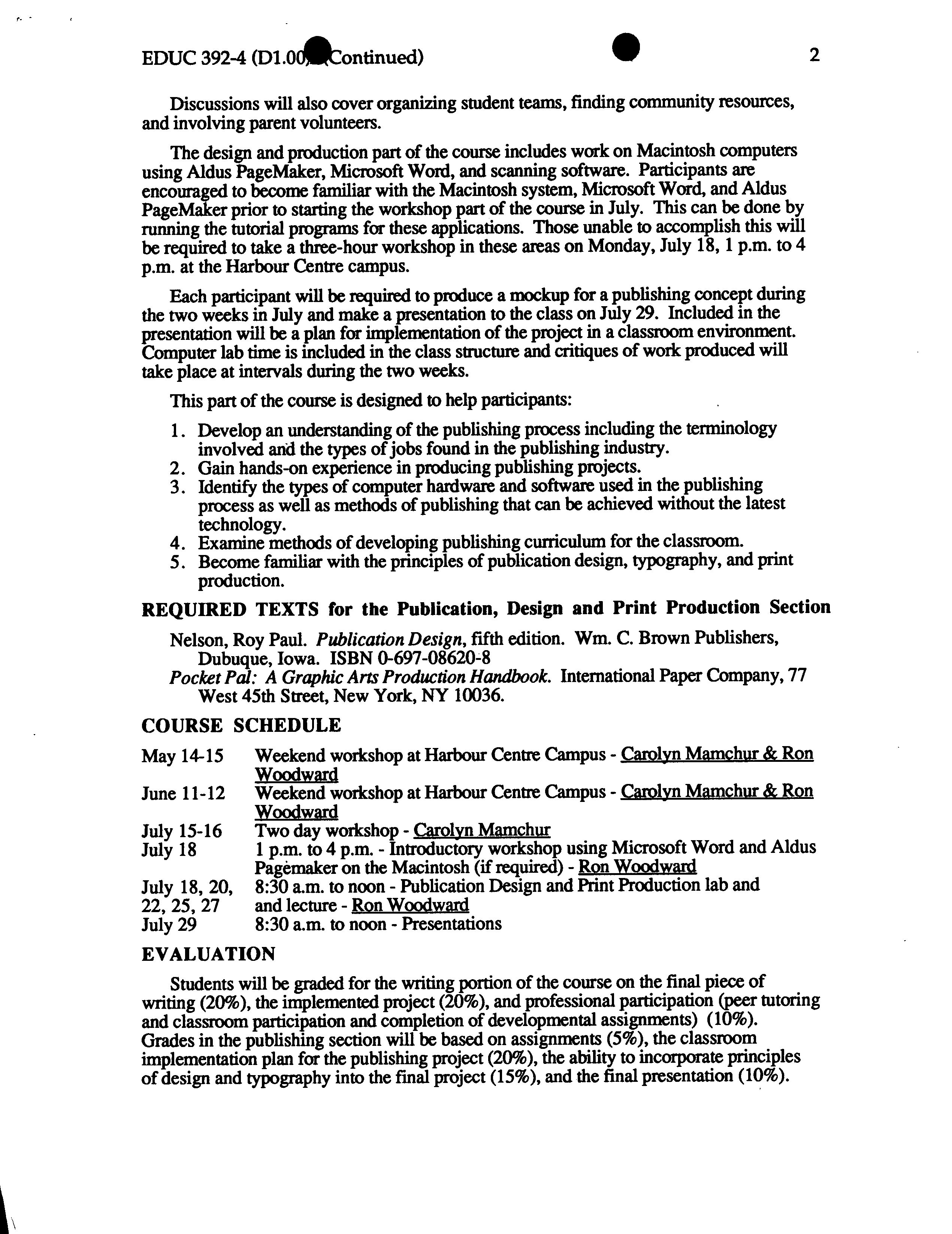. ?
.
SIMON FRASER UNIVERSITY?
EDUCATION 392-4 (D1.00)
?
SPECIAL TOPICS: CLASSROOM WRITING & PUBLISHING
?
(Cat. #14291)
Regular Summer Semester, 1994
?
Instructor: ?
Carolyn Mamchur
(May 2—July 29) ?
291-3661
Dates: ?
Refer to page 2
?
Ron Woodward
879-7601
Location: Harbour Centre
COURSE DESCRIPTION
Writing and Publishing in Schools
is an intensive program for people who want to
teach writing and publishing. Producing publishing projects offers an excellent
interdisciplinary exercise that brings practical applications of education into the classroom.
Publishing projects can be produced in a team - simulated publishing environment - and
utilize skills in writing, editing, art, design, photography, business, marketing, and
computer applications.
The curriculum for this course is divided into two areas.
Writing - Carolyn Mamchur
This part of the course is founded on several beliefs concerning the teaching of writing.
1.
Teachers of writing must, themselves, be able to write well.
2.
You learn to write by writing.
3.
Writing is a varied, individual process, a series of stages that move from conception
to revision.
4.
Constructive evaluation demands that as well as responding to form and usage, the
teacher responds to the author as a person, and to the message as thoughtful
communication.
It is the purpose of this section of the course to enable teachers to demonstrate
awareness of writing process techniques and ability to use and teach them in their
classrooms (focus will be on grades 4-12).
The writing/teaching writing component of this course concentrates on the learning of
four specific writing skills which students will be expected to master and to demonstrate
ability to others. The four skills are:
1.
Discovering a subject
2.
Searching for specifics
3.
Sensing an audience
4.
Creating a design
The teaching aspect of the course concentrates on peer editing strategies, critical
analysis, helpful evaluation practices and such practical considerations as topic selection
and creating climates conducive to taking risks.
Publication Design and Print Production - Ron Woodward
This part of the course will cover five topic areas.
1.
The publishing process and how to adapt it to the classroom
2.
Principals of publication design and the relationships between readership, format,
and design
3.
Typographic rules of thumb
4.
Computer applications in publication design and production
5.
Print production techniques
(see over)
EDUC 392-4 (131.00ontinued)
Discussions will also cover organizing student teams, finding community resources,
and involving parent volunteers.
The design and production part of the course includes work on Macintosh computers
using Aldus PageMaker, Microsoft Word, and scanning software. Participants are
encouraged to become familiar with the Macintosh system, Microsoft Word, and Aldus
PageMaker prior to starting the workshop part of the course in July. This can be done by
running the tutorial programs for these applications. Those unable to accomplish this will
be required to take a three-hour workshop in these areas on Monday, July 18, 1 p.m. to 4
p.m. at the Harbour Centre campus.
Each participant will be required to produce a mockup for a publishing concept during
the two weeks in July and make a presentation to the class on July 29. Included in the
presentation will be a plan for implementation of the project in a classroom environment.
Computer lab time is included in the class structure and critiques of work produced will
take place at intervals during the two weeks.
This part of the course is designed to help participants:
1.
Develop an understanding of the publishing process including the terminology
involved and the types of jobs found in the publishing industry.
2.
Gain hands-on experience in producing publishing projects.
3.
Identify the types of computer hardware and software used in the publishing
process as well as methods of publishing that can be achieved without the latest
technology.
4.
Examine methods of developing publishing curriculum for the classroom.
5.
Become familiar with the principles of publication design, typography, and print
production.
REQUIRED TEXTS for the Publication, Design and Print Production Section
Nelson, Roy Paul.
Publication Design,
fifth edition. Wm. C.
Brown Publishers,
Dubuque, Iowa. ISBN 0-697-086208
Pocket Pal: A Graphic Arts Production Handbook.
International Paper Company, 77
West
45th
Street, New York, NY 10036.
COURSE SCHEDULE
May 14-15 Weekend workshop at Harbour Centre Campus - Carol
y
n Mamchur & Ron
Woodward
June 11-12 Weekend workshop at Harbour Centre Campus - Carolyn Mamchur & Ron
Woodward
July
15-16
Two day workshop - Carolyn Mamchur
July 18
?
1 p.m. to 4 p.m. - Introductory workshop using Microsoft Word and Aldus
?
Pagèmaker on the Macintosh (if required) - Ron Woodward
July 18, 20, 8:30 a.m. to noon - Publication Design and Print Production lab and
22, 25, 27
?
and lecture - Ron Woodward
July 29 ?
8:30 a.m. to noon - Presentations
EVALUATION
Students will be graded for the writing portion of the course on the final piece of
writing (2096), the implemented project (20%), and professional participation (peer tutoring
and classroom participation and completion of developmental assignments) (10%).
Grades in the publishing section will be based on assignments (5%), the classroom
implementation plan for the publishing project (20%), the ability to incorporate principles
of design and typography into the final project (15%), and the final presentation (10%).


